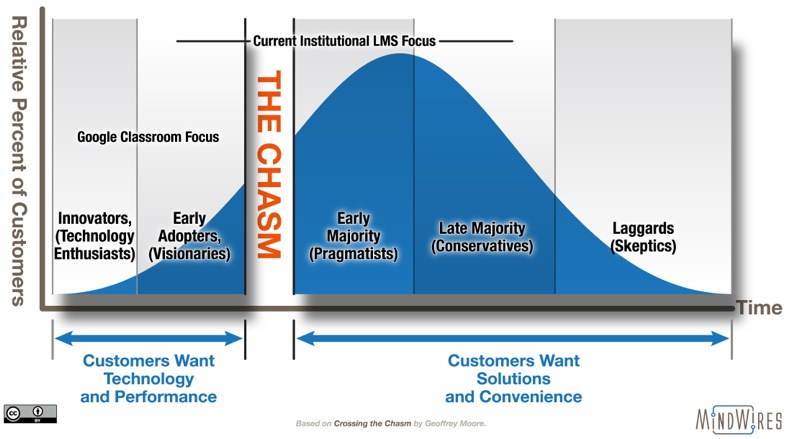Yesterday I shared a post about the new Google Classroom details that are coming out via YouTube videos, and as part of that post I made the following statement [emphasis added]:
I am not one to look at Google’s moves as the end of the LMS or a complete shift in the market (at least in the short term), but I do think Classroom is significant and worth watching. I suspect this will have a bigger impact on individual faculty adoption in higher ed or as a secondary LMS than it will on official institutional adoption, at least for the next 2 – 3 years.
The early analysis is based on this video that shows some of the key features:
https://www.youtube.com/watch?v=K26iyyQMp_g
There is also a new video showing side-by-side instructor and student views that is worth watching.
Here’s why I believe that Classroom will not affect the LMS market for several years. Google Classroom is a slick tool that appeals to individual instructors whose schools use Google Apps for Education (GAE) – primarily K-12 instructors but also to higher ed faculty members. The tight integration of Google Drive, Google+ and GAE rosters allows for easy creation of course sites by the instructor, easy sharing of assignments and documents (particularly where the instructor creates the GDrive document and has students directly edit and add to that document), and easy feedback and grading of individual assignments. Working with the GAE framework, there are a lot of possibilities for individual instructors or instructional designers to expand the course tools. All of these features are faculty-friendly and help Google’s promise of “More time for teaching; more time for learning”.
But these features are targeted at innovators and early adopter instructors who are willing to fill in the gaps themselves.
- The course creation, including setting up of rosters, is easy for an instructor to do manually, but it is manual. There has been no discussion that I can find showing that the system can automatically create a course, including roster, and update over the add / drop period.
- There is no provision for multiple roles (student in one class, teacher in another) or for multiple teachers per class.
- The integration with Google Drive, especially with Google Docs and Sheets, is quite intuitive. But there is no provision for PDF or MS Word docs or even publisher-provided courseware.
- There does not appear to be a gradebook – just grading of individual assignments. There is a button to export grades, and I assume that you can combine all the grades into a custom Google Sheets spreadsheet or even pick a GAE gradebook app. But there is no consistent gradebook available for all instructors within an institution to use and for students to see consistently.
For higher ed institutions in particular, we are just now getting to the stage where the majority of faculty use the institutional LMS. I am seeing more and more surveys on individual institutions where 70+ % of faculty use the LMS for most of their courses. What this means, however, is that we have a different categories of adopter for institutional LMS – the early majority (characterized by pragmatic approach) and late majority (characterized by a conservative approach) as shown by the technology adoption curve. I am showing the version that Geoffrey Moore built on top of the Everett Rogers base model.
With adoption often above 50% or more of faculty, the institution has to serve both the group on the left (innovators and early adopters) and the larger group on the right (early and late majority more than laggards). As poorly designed as some of the institutional LMS solutions are, they typically allow automatic course and roster creation with updates, sharing of multiple document types, integrated standard gradebooks, and many others.
Institutions can (and really should) allow innovators and early adopters to try out new solutions and help create course designs not bound by the standard LMS implied pedagogy, but institutions cannot ignore the majority faculty who are typically unwilling to spend their own time to fill in the technology gaps – especially now that these faculty are just getting used to LMS usage.
None of this argues that Google Classroom is an inferior tool – it is just not designed to replace the full-featured LMS. Remember that Google is a technology-vision company that is comfortable putting out new tools before they understand how the tools will be used. Google is also comfortable playing the long game, getting more and more instructors and faculty using, giving feedback, and pushing forward the new toolset. This process will take some time to play out – at least 2 or 3 years in my opinion before a full institutional LMS may be available. If Google like the direction Classroom usage is going.
Google Classroom does attempt to partially understand the instructor use cases, but is not designed as a holistic product. Think of Classroom as ‘let’s see how to tie existing Google tools together to advance the ball in the general course site world’. It is still technology first and tied more specifically Google technology first. The use cases are simple (e.g. one instructor sharing GDrive-based assignment to students who edit and then submit for feedback), but there are many possibilities for clever faculty to innovate.
In the near-term, Google Classroom will likely be a factor for individual faculty adoption (innovators, early adopters) at schools with GAE licenses or even as secondary LMS. But not as a replacement.

[…] has released a video promoting its new Classroom tool. It’s not quite an LMS, but Google Apps for Education fans appear giddy at the prospect […]